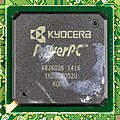Kyocera
Kyocera Corporation (京セラ株式会社, Kyōsera Kabushiki-gaisha, pronounced [kʲoːseɾa]) is a Japanese multinational ceramics and electronics manufacturer headquartered in Kyoto, Japan. It was founded as Kyoto Ceramic Company, Limited (京都セラミック株式会社, Kyōto Seramikku Kabushiki-gaisha) in 1959 by Kazuo Inamori and renamed in 1982. It manufactures industrial ceramics, solar power generating systems, telecommunications equipment, office document imaging equipment, electronic components, semiconductor packages, cutting tools, and components for medical and dental implant systems.
Native name
京セラ株式会社
Kyōsera kabushiki gaisha
1959
- Goro Yamaguchi (Chairman)
- Hideo Tanimoto (President)
- Semiconductor packages
- Industrial components
- Automotive components
- Electronic devices
- Solar power generating systems
- Printers
- Copiers
- Mobile phones
- Applied ceramic products
¥1.577 trillion (2018)
¥81.79 billion (2018)
70,153 (March 31, 2017)
History[edit]
Origins to 2000[edit]
Kyocera's original product was a ceramic insulator known as a "kelcima" for use in cathode-ray tubes. The company quickly adapted its technologies to produce an expanding range of ceramic components for electronic and structural applications. In the 1960s, as the NASA space program, the birth of Silicon Valley and the advancement of computer technology created demand for semiconductor integrated circuits (ICs), Kyocera developed ceramic semiconductor packages that remain among its core product lines today.
In the mid-1970s, Kyocera began expanding its material technologies to produce a diverse range of applied ceramic products, including solar photovoltaic modules; biocompatible tooth- and joint-replacement systems; industrial cutting tools; consumer ceramics, such as ceramic-bladed kitchen knives and ceramic-tipped ballpoint pens; and lab-grown gemstones, including rubies, emeralds, sapphires, opals, alexandrites and padparadschahs.
The company acquired electronic equipment manufacturing and radio communication technologies in 1979 through an investment in Cybernet Electronics Corporation, which was merged into Kyocera in 1982. Shortly afterward, Kyocera introduced one of the first portable, battery-powered laptop computers, sold in the U.S. as the Tandy Model 100, which featured an LCD screen and telephone-modem data transfer capability.
Kyocera gained optical technology by acquiring Yashica in 1983, along with Yashica's prior licensing agreement with Carl Zeiss, and manufactured film and digital cameras under the Kyocera, Yashica and Contax trade names until 2005, when the company discontinued all film and digital camera production.
In the 1980s, Kyocera marketed audio components, such as CD players, receivers, turntables, and cassette decks. These featured unique elements, including Kyocera ceramic-based platforms. At one time, Kyocera owned the famous KLH brand founded by Henry Kloss, though Kloss and the original Cambridge design and engineering staff had left the company by the time of the Kyocera purchase. In 1989, Kyocera stopped production of audio components and sought a buyer for the KLH brand.
In 1989, Kyocera acquired Elco Corporation, a manufacturer of electronic connectors. In 1990, Kyocera's global operations expanded significantly with the addition of AVX Corporation, a global manufacturer of passive electronic components, such as ceramic chip capacitors, filters and voltage suppressors.
Expanding sales of photovoltaic solar energy products led the company to create Kyocera Solar Corporation in Japan in 1996, and Kyocera Solar, Inc. in the U.S. in 1999.
On August 4, 1999, Kyocera completed its merger with solar energy systems integrator Golden Genesis Company (Nasdaq:GGGO).[1]
Corporate affairs[edit]
Kyocera's headquarters building in Kyoto is 95 metres (312 ft) tall. A 1,900-panel photovoltaic power system is on the roof and south wall of the building, which can supply 12.5% of the facility's needed energy, generating 182 megawatt hours per year.[15]








